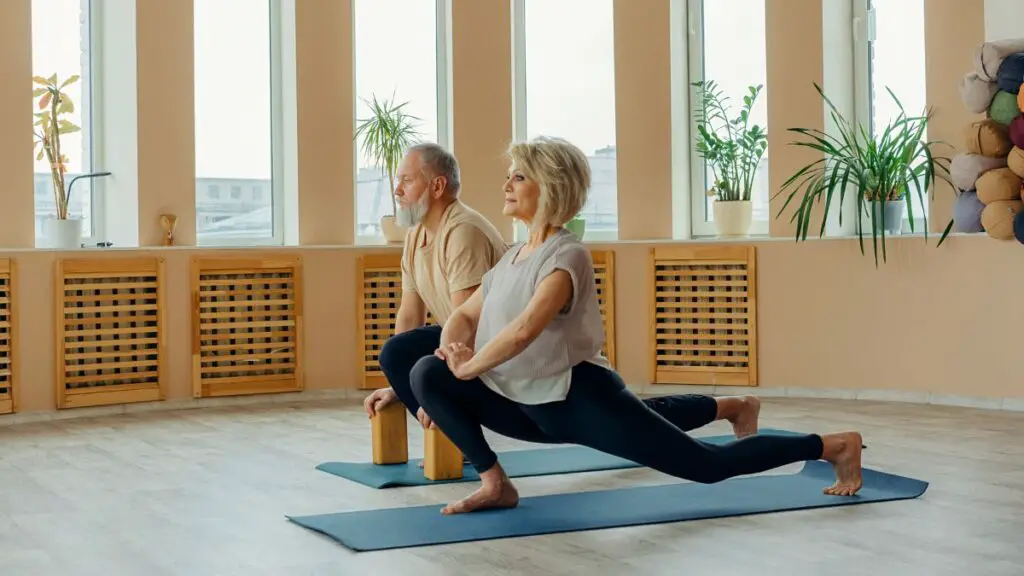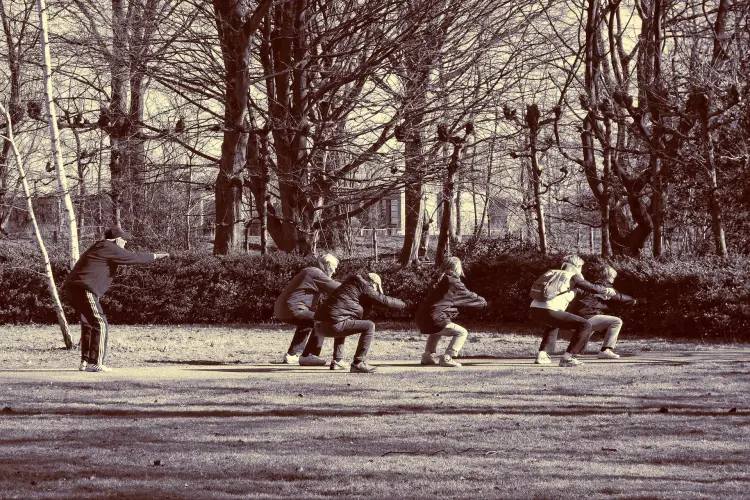You’ve likely witnessed somebody older you love or care about fall and then watched over the months as to how their life has changed. There are leg exercises to reduce falls that every able senior should incorporate as they age and mobility becomes compromised.
One out of every five falls ends up causing a broken bone or head injury, and these can have major repercussions on one’s life. In particular, a broken hip can prove to be exceptionally nasty. Considering that 95% of all broken hips occur due to falls, it’s vital that we take a look at what some of the things are we can do to help to prevent these falls.
One of the things that will work in our favor to decrease falls is to improve leg strength. Weak legs are most certainly a risk factor when it comes to falling. This is where lifting weights comes into play. If we can improve our leg strength, we can help to minimize the risk of falling.
But just what leg exercises can help to build up leg strength to do this? Let’s take a deep dive into the subject.
Why Seniors Lose Muscle Strength
Age typically is associated with inactivity. Nobody in their 70s will admit to being more active than what they were in their early 20s. There’s a number of reasons for this, but the end result is that older people lose muscle mass. Use it or lose it.
When you combine this inactivity with hormone changes (less testosterone and human growth hormone), typically a decreased calorie intake, pain, and a number of other factors, the end result can very easily be a loss of both muscle strength and size.
(If it’s sarcopenia, in particular, that you’re concerned about here, check out our in-depth look at the subject.)
The problem here is that this then results in a decreased quality of life. Because the person is weaker, they are more likely to experience injuries, deal with increased levels of pain, and are going to have a harder time performing daily activities of life.
Maintaining and building strength, even when a senior, is vital as a result.
Leg Exercises to Reduce Falls in Seniors
I spent several years working as a personal trainer. Below are some of what I believe to be the best leg exercises to help seniors to reduce falls. I will give the caveat, however, that before you begin any exercise program, you really need to clear things over with your doctor.
Also, I’m not telling you to do these exercises, I’m just telling you that these were some of the standard battery of leg exercises that I would give my clients. Which ones they would be cleared to do depended on their personal health conditions.
So, for informational purposes only, these are the ones I would typically give my clients:
1 – Squats
Arguably, this is one of the most important leg exercises that can be done to help prevent falls in older people. The catch here is that a lot of seniors have knee pain that keeps them from being able to do a typical squat without experiencing pain.
I didn’t have the facility to do back barbell squats with my clients, and don’t really think that’s necessarily the best route to go with seniors anyways. The variations of squats I would regularly prescribe were bodyweight squats (typically from a chair), goblet squats (again, from a chair), TRX squats, or suitcase squats from a chair.
Squats of any form will hit pretty much the entire leg musculature. For information on how to engage in a generic squat properly, I recommend checking out the below video:
2 – Leg Curls
I really like leg curls. I had a seated leg curl machine that I would use for my clients, and I could even get my clients with knee pain to perform this exercise without any discomfort about 99% of the time.
For advice on how to perform this exercise, check out the following video from a guy who literally never wears a shirt in his videos:
This exercise helps to target the hamstrings. In a lot of people, the front of the thigh is much stronger than the back of the thigh, and this muscular imbalance can result in some problems. For example, one study of female athletes found that training their hamstrings was an appropriate means to help to decrease the risk of an ACL tear.
3 – Calf Raises
This is a very simple exercise that I was able to get just about everybody to perform safely unless they had gout, fused ankles, or some other serious foot problem. I would give people something sturdy to hang onto and then tell them to pretend that they were Wilson from Home Improvement peeking over the fence.
All they had to do was go up on their tip toes and then back down over and over. Doing so helps to build up the calves. It stands to reason as well that if somebody has weak ankles, building up the muscles around those joints can help to prevent ankle sprains as well.
Check out this video for advice on how to perform this exercise properly:
4 – Seated Straight Leg Raises
This is an exercise I would turn to to build up the front of the thighs if somebody had knee pain that kept them from doing much else to work that area. I would have the client sit against the wall, normally with a wedge pillow behind their back to make things comfortable, and with both of their legs laying straight out in front of them.
Then, the client would lift their right leg off the ground 10+ times in a row. Then, we would do the left leg 10+ times in a row. So, they would start in a ‘L’ position, and then lift that one leg so that they were in a ‘V’ position. I only ever had people lift their leg as high as was comfortable for them. Often, this was only a few inches off of the ground.
However, by doing this exercise, they help to build up a muscle in the front of their thigh without the knee ever being bent.
5 – Bridges
Here’s another cool leg exercise I could get virtually 100% of my clients to engage in, even if they had knee pain. All they had to do was lay on their back with their knees bent and then pick their butt up off the floor.
I wanted them to flex their butt in the process. It’s their butt that’s supposed to be picking them up off the floor here, and one really needs to mentally focus to engage those muscles. I found that telling people to flex their butt as hard as possible and hold it for 1-2 seconds (hold the contraction, don’t physically grab your butt) helped people to learn what it felt like to use the glutes to perform the exercise.
This exercise will not only target the butt, however. It also engages the hamstrings, and to an extent, will work the top of the thighs a bit as well.
6 – Seated Hip Abductions
You know that machine at the gym where you sit in and push your legs against? It makes you look something like a crab/a promiscuous woman. I’ve heard more than one woman refer to this as the “baby making machine.”
It’s a great exercise to help build up your butt, which is vital to helping you to maintain balance. Since there’s no active extension of the knee going on here either, people with knee pain could do it without problem. I did have to be careful with putting somebody on this machine that had sciatica, though.
7 – Deadlifts
Of all the exercises on this list, deadlifts are the one that were the most difficult to teach. If you’re even going to consider incorporating deadlifts into an exercise routine, please find a personal trainer who knows what they’re doing to teach you. I don’t want you hurting your lower back.
When performed properly, this is a great exercise for building up one’s butt and legs. Typically, I utilized kettlebell deadlifts for my older clients, maybe even having them lift the kettlebell off of a little box so that they didn’t have to bend down as far as well.
While a fantastic exercise that really gives you good results for your effort, it truly needs to be understood when one is engaging in it.
8 – Leg Extensions
It’s become somewhat fashionable within the personal training world the past 10 years to knock this exercise (thank you, Crossfit), but I still think it holds value. People argue that it’s not a “functional” movement. I agree with personal trainer Bret Contreras: strength is functional. Who cares about the movement pattern if the exercise safely builds strength that improves one’s quality of life?
Typically, if somebody had bad knee pain, I wouldn’t have them do this exercise. The kneecap gets driven back into the leg bones on this one, which, if you have arthritis, hurts. Otherwise, it was typically fine.
This is a fairly simply exercise for building up the front of the thighs, that really doesn’t require much in the way of “training” either.
9 – Clamshells
I liked using a miniband for these with my clients. This exercise is about as simple as it gets. Lay on your side in something of the fetal position. Your knees are bent. It’s like you’re spooning.
The miniband is placed around both legs and brought up right above the knees (don’t put it on your knees). Then, hinge from the hip and open your legs up, just like a clam. Do this X number of times and then flip over and do the same thing on the other side.
This is an easy way to help to build up the butt. Click here if you’re looking for other ways to help build up a saggy butt.
10 – Weighted Knee Raises
Typically, I would have my clients do these seated. They’d be in a chair, have an ankle weight on (sometimes, I would just have them hold a dumbbell on top of their thigh) and then lift up that leg X number of times. Then, we’d switch and do the other leg.
This would help us to build up the top of the thigh without any active knee extension, meaning that there was virtually zero chance there would be any knee pain with this exercise.
Does Walking Strengthen Your Legs?
Walking is something that virtually everybody needs to do more of, but I think it is far from being the best exercise out there to strengthen your legs. If you want to strengthen your leg muscles to decrease your risk of falls, you need to engage in strength training.
I’m simplifying here, but there are two main types of muscle fibers: fast-twitch and slow-twitch. Walking would be considered an endurance activity and helps to build the slow-twitch fibers as a result. Strength training helps to build the fast-twitch. When it comes to building up what we typically would call “leg strength,” you are looking at building up these fast-twitch fibers.
Walking is not good at doing that. It won’t do that. You need to engage in actual strength training to see benefit here. (Check out here for some cool exercise products you may like.)
Conditions that Cause Sudden Leg Weakness in Seniors
If sudden leg weakness has occurred, you need to get yourself to a doctor pronto. If I had a client that came into me and complained of this, the first thing I would do would be to look for signs of stroke. The next thing I would do would be to ask them if they’ve fallen of late.
I’ve witnessed people with injured backs suddenly develop leg weakness, seen how Parkinson’s can do this seemingly overnight, and there are a host of other possibilities here as well.
Your best bet here, should this be the case with you, is to ask your doctor what on earth is going on. They will be able to diagnose the problem (if there is one), and set you on the right track.
Building strength is possible.
One of the cool things about the human body is that it can adapt to stress, and strength training is a form of stress. Just because your legs are weak now doesn’t mean that they necessarily have to remain that way. There are typically always methods that we can use to help to boost one’s strength. But what are your thoughts on the subject? Let us know what you’re thinking in the comments.




